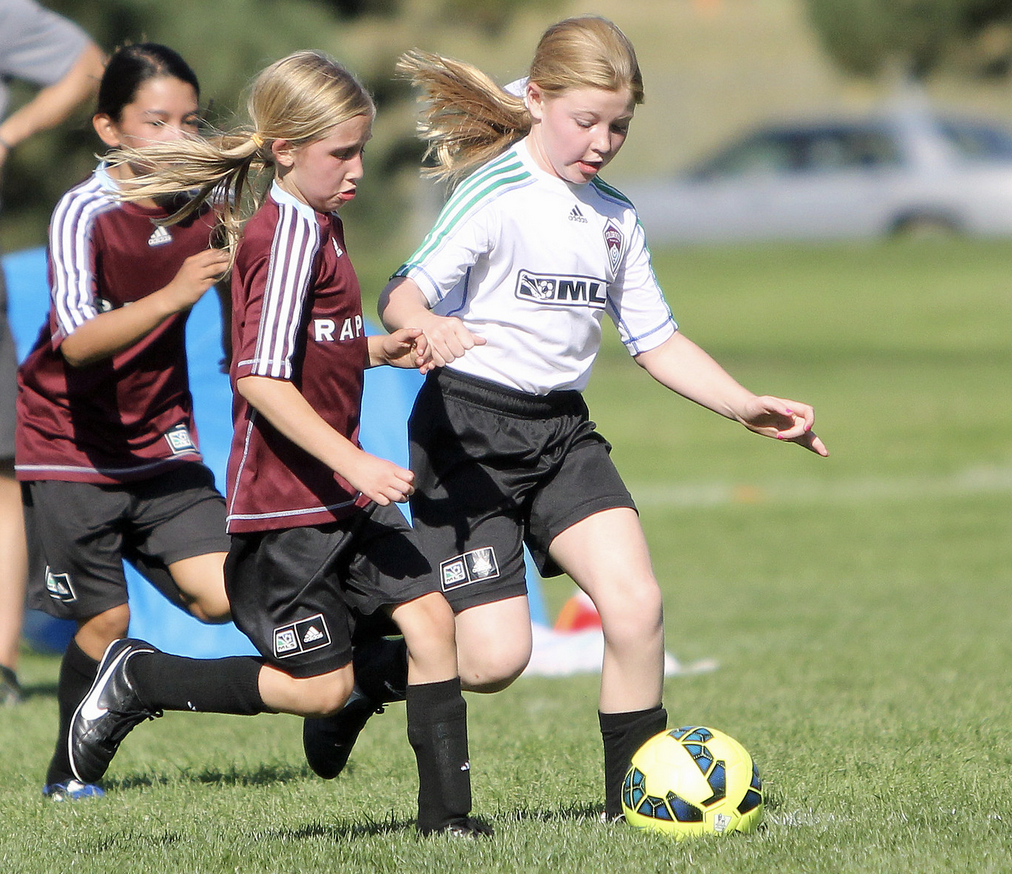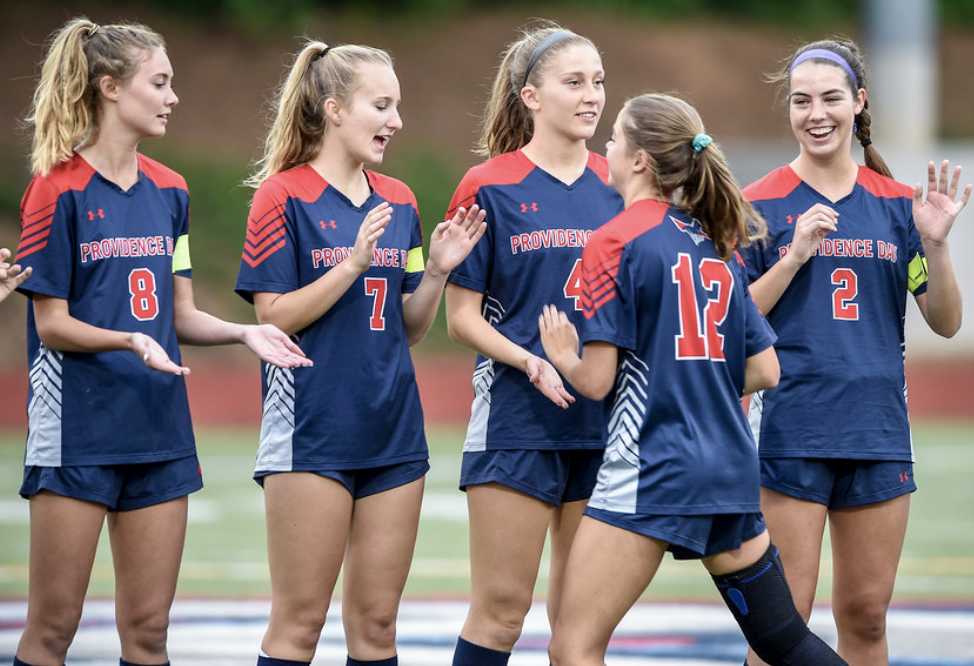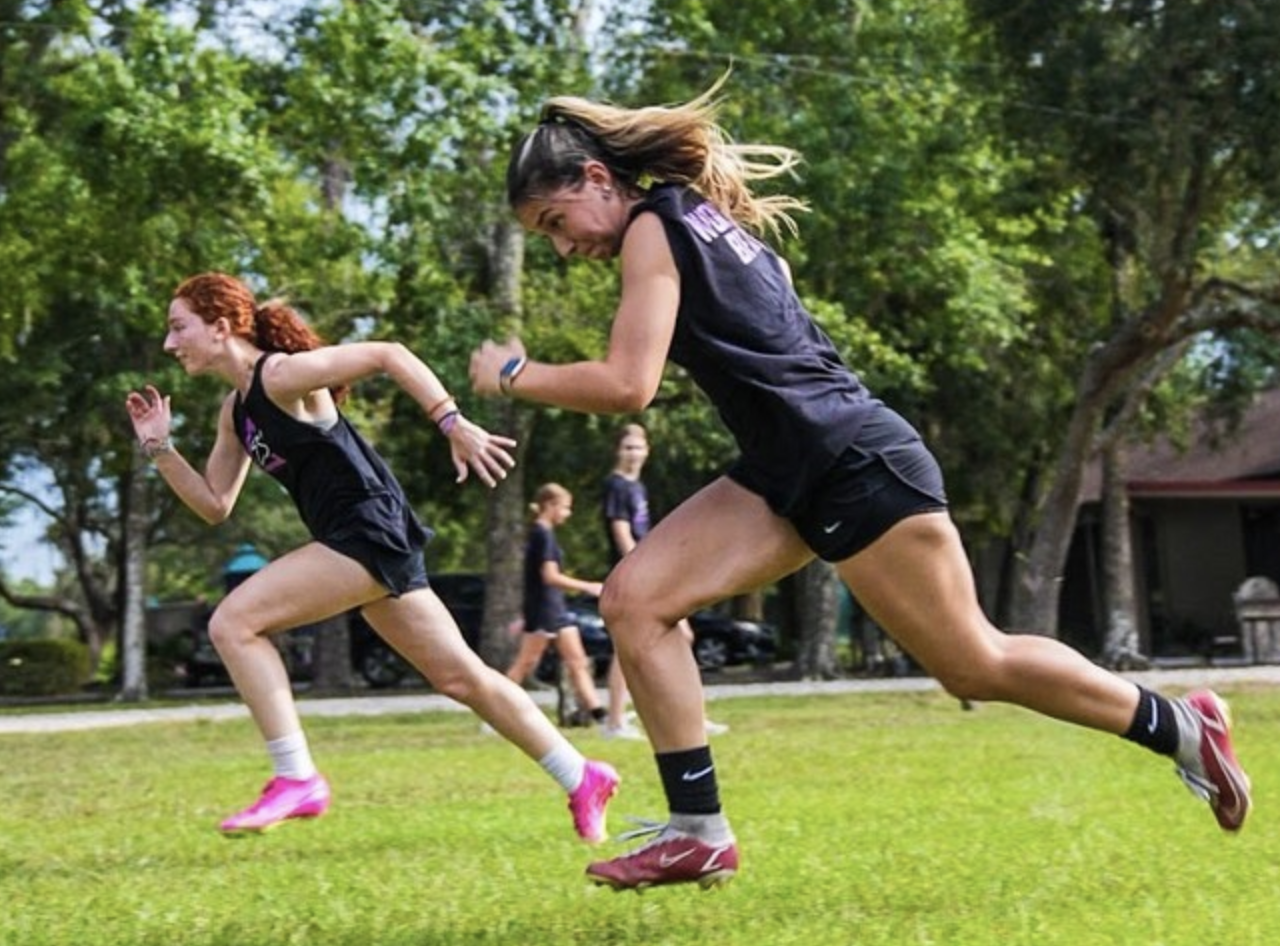
10 Oct What Youth Girls Soccer Player Development REALLY Means
As much as you think you know what soccer player development means, you don’t.
I’m sure you see these promises plastered across every youth sports club’s social media:
“We focus on player development!”
“We make player development our priority!”
“Our mission is true player development!”
And I’m sure you’re captivated by these promises. You might think, ‘wow, they’re not like other clubs..’
So you hop to this new, promising club the next season, thinking this time, maybe, just maybe, the grass will be greener.
But it isn’t.
You realize that ‘player development’ was an alluring catch phrase to reel you in, make you pay your dues, buy the $300 uniforms, and your child either stagnates as a player, or worse yet, declines in the process.
What Player Development Really Is
Let’s do a litmus test to see if your club is practicing true player development. Do some digging, talk to other parents, and ask this question: what’s been the turnover rate?
How long have young players stuck with this club? Did people last all about 2 seasons, then hop to another club? Did they last only a season? Or did they hang around all the way from U12 to U18?
Ideally, player development is the latter. It’s the entire process of youth development, nurturing the athlete within a system of quality coaching, and allowing them to blossom throughout their teenage years until they leave for college.

I’d argue that very few clubs can say they have retained players from the grassroots level to the older, elite levels. Maybe this is because they don’t have a clear pathway and process for the kids. Some of the only youth clubs I see who have a crystal clear development pathway that is long-term are many of the youth academies in Europe.
Expounding further, they have a physical development curriculum where young players are exposed to a variety of movements, with gymnastics-like training and jungle gyms, so they develop into well-rounded athletes. The health of the kid is first and foremost. Europe academies want to ensure kids avoid overuse injuries at all costs and they have a team of certified strength coaches who specialize in youth development, and additionally, they have teams of growth and maturation researchers involved.
The European kids aren’t early specializers because they’re getting athletic development and foundational motor skills within the club system.

In America? It’s everyone for themselves, with coaches running kids ad nauseam through ladders, laps around the field, and mundane Indian Runs that look like work, when no work is getting done. This is not true player development. This is overuse injury enhancement.
Before I move on, I want to provide a disclaimer: I’m not saying ALL youth soccer clubs in America are doing player development wrong.
I have many colleague friends who are DOCs as well girls coaches who are doing it the right way for their ECNL, ECNLR, and GA teams.
But most aren’t doing it right, and they ruin it for everyone else. So if you feel this is you and you’re triggered by this article, that’s a good thing. It means it’s time to level up.
The Pillars of Player Development
Player development encompasses the technical, tactical, physical, and mental aspects of the game. Too often, clubs only cover two of these, namely, technical and tactical. But even within these two, the quality is poor.
Technical training, for example, has turned into a complete catastrophe in the United States, and it’s as if every skills trainer or coach is just competing for the coolest drills to post on social media. This isn’t coaching. This isn’t developing. Unopposed skills drills, where coaches lay out a rainbow of cones and hurdles during Technical Training Night, is not developing a technically sharp and creative player. It’s developing a robot. It’s too predictable. Soccer is a thinking game and coaches must develop their players this way.

Top creativity researcher, Joel Cressman, says this is where many fall short: most technical trainings don’t translate to the game. Think about it, every technical action in soccer involves a decision-making component, so true player development is leaning more toward this in training. Now this isn’t to say there isn’t a need for unopposed ball mastery. There is. But most players must master the ball on their own time.
I’d argue, clubs skills trainers rely heavily on unopposed skill work and miss the mark on chaotic, small-sided game skill work. As a result, we are losing creative players.
Joel Cressman argues, “creative players will be the players of the future.” With video technology and teams able to study opponents, creative players will be able to shock their competition. Creative players have a library of skills, runs, and unpredictable moments that no opponent can study on film or see on TikTok.
On Bench Players
Player development is not just letting your starters shine, but also, uplifting your bench players. One of the biggest misses is coaches not helping their bench players get into the starting line-up. They’ll give them a vague, “well, you just need to improve your fitness” because it’s an easy cop-out for the coach to avoid the hard responsibility of true development. The player is then left confused and hopeless on what to do. “Just work on your fitness,” the coach repeats. Ummm…what?
I call bs on this. Coaches need to develop their bench players instead of give stupid, vague excuses, like “improve your fitness” or “improve your first step quickness.”
Bench players should still be doing conditioning at practice or after games to match the loads that starters are getting. Otherwise, how else will they work their way up to the starting line-up? Player development is also load management and understanding who is under-loading (i.e. the bench players) and how can coaches help these players load so they continue to develop their speed and fitness.
As an example, coaches could run the bench players immediately post-game so they get a similar conditioning effect to the starters, or have them train at a higher intensity in the practices leading up to game day. This gives bench players a chance at developing, and hopefully, breaking into the starting line-up one day.

Bench players are so incredibly de-trained nowadays because coaches ignore this piece. And parents of bench players also are paying thousands of dollars a year. It’s depressing. So at a minimum, let’s also develop the bench players to match the fitness demands of the starters, and make the club dues and travel costs worth it.
On Physical Development and ACL Injury Prevention for Girls Soccer Players
Player development is keeping players healthy first and foremost. The goal is game availability. After all, clubs need to field full, healthy squads in order to compete.

We have come a long way in providing more on the injury reduction front, but sometimes, it seems people are just trying to check a box. They say they’re doing “injury reduction” when in reality, the club-wide strength coach is an underpaid, glorified stretching and recovery coach. They have very little impact.
First things first:
One club-wide strength coach can’t move the needle for the whole club. So what should clubs do? Develop a strong network of local, certified strength and conditioning coaches to REFER THEIR GIRLS PLAYERS TO. Alas, clubs don’t do this because they want everyone seeing their club-wide coach because he is associated with their GOOD OL’ BOYS club. Of course they don’t want to send their girls players to other certified professionals. This isn’t player development, folks. This isn’t serving our girls players.
This is doing our girls soccer players a major disservice because one club-wide strength coach can’t program individual, customized programs for an entire club with hundreds of girls. So what happens? Quality goes down. Girls don’t progress. ACLs still rise. No weights or speed times are tracked. The club-wide strength coach implements white board workouts, or a core circuit thrown together minutes before girls show up to a session. The girls lift all but 20lb dumbbells on a Goblet Squat, when they should be progressing their front squat relative to body weight to truly get strong. Did I mention, ACLs still rise?
Don’t confuse club-wide strength coach with proper physical development. Too often parents are disappointed their girls soccer team has ACLs and they ask, ‘why are so many injuries happening? We have a club strength coach!’ This is why folks. The quality just isn’t there.
Girls need individual programming and proper progression. They shouldn’t be lifting the same weight all year. They should work toward dead lifting over their body weight, pistol squatting 20% of their body weight, split squatting 50-75% of body weight, doing a perfect push-up (no hips drooping!) and doing a perfect pull-up (no swinging like a freaking CrossFit class!), building their Reactive Strength Index (RSI) with proper plyometric progression, and cleaning up sprint and acceleration mechanics to raise the ceiling on their speed.

Injury reduction isn’t cute little balance drills and random circuits. It’s challenging the muscles with more load over time with quality strength and speed training. Injury reduction is also attention to detail – girls being taught proper lifting technique, biomechanics of the ankle, knee and hip for change of direction, and jumping and landing drills. Injury reduction is loading heavy on the main lifts – hex bar deadlift and squat. Injury reduction is careful attention to individual programming based on the athlete’s training age, exercise/injury history, and goals.

Player Development Isn’t Social Media Clout
Maybe one day clubs will spend less money on social media videographers, club signing day backdrop banners, expensive uniforms and high-end merch parents are required to buy, and actually invest in the pillars of development.
Maybe one day, soccer clubs will build jungle gyms and athletic development centers so kids build all muscle groups, avoid overuse injuries, and become more coordinated, stronger and faster athletes. Maybe one day, clubs will invest in quality strength coaches – not just one for the whole club – but several who can give girls soccer players attention to detail for optimal ACL injury prevention. Or at the very least, maybe one day, clubs will check their egos, and refer out to other certified strength coaches in their area.
Maybe one day, clubs will focus more on sharing who stuck with them for the long haul, and their success is based on who stayed in their pathway from U12-U18. Maybe one day, clubs will highlight their athletes who didn’t go to college for soccer, but for academics.
Maybe one day, they’ll have a clear development pathway that addresses the pillars of technical, tactical, physical and mental and outline their step-by-step plan to nurture these long-term.

I’m over 1,000 words into this article and this was just the warm-up. I’ve touched a lot on the physical piece, so now it’s time to address the mental piece. Let me turn it over to my collaborator, Dave Gleason, who has worked in youth development for over three decades.
Just like Tiesto handing over the DJ table to Hardwell, take it away Dave.
Part II by Coach Dave Gleason
Thank you, Erica. What a great summary of a very complex and inclusive topic.
Long Term Player Development is a lot more than just the slow and steady “grind” (I’m starting to really dislike the overuse and misrepresentation of this word) of training sessions and workouts that are developmentally and chronologically appropriate. Don’t get me wrong, the science of progressive training matters. But when we reduce a young athlete’s development to a calendar of drills and conditioning blocks, we miss the bigger picture.
Sports management, mental performance, branding, schoolwork, social circles, and let’s not forget the very real physical and emotional demands of growing up…these are all part of the equation. And they’re also potential points of stress.
So when we talk about Player Development, we can’t ignore the human behind the athlete. Especially for young girls soccer players in today’s world.

The Conundrum of Growing Up in Sports
Growing up and having a career in sports as a student-athlete in 2025 is a conundrum.
A career? you ask.
Yes.
If a child begins playing at 5 years old, by the ripe old age of 15 they’ve already had a 10-year career. Think about that. Ten years of practices, games, tournaments, travel, uniforms, cleats, shin guards, team photos, emotional highs and lows, wins, losses, and lessons learned.
When you frame it like that, no wonder so many young athletes feel pressure, fatigue, or even burnout by the time they hit their mid-teens.

This is where we have to zoom out, look at the bigger picture and what is most important. A “career” at that age doesn’t mean we treat our kids like pros. It means we have a responsibility to help them navigate not just the athletic side of development, but the whole person.
The Myth: Development vs. Well-Being
There’s a common myth that Player Development and an athlete’s overall well-being are mutually exclusive, as if to be competitive and successful, an athlete must sacrifice joy, health, and balance.
That couldn’t be further from the truth.
True development only happens when a player’s body, mind, and spirit are supported in harmony. When training volume, recovery, social support, and mental health are aligned, athletes not only improve (develop) faster, they stay in the game longer.

But here’s the kicker: when well-being is ignored, the development curve collapses. Injuries increase. Motivation dips. Confidence erodes. And the joy that made them fall in love with soccer in the first place? It disappears.
Stress Points in a Young Athlete’s Life
Let’s get practical. Here are some of the most common stress points for young girls soccer players. These are all real life issues my athletes and their families are faced with in the current landscape of youth sports. The topics I’m about to list for you are topics on the short list of what I consult my athletes on everyday.
1.The Pressure of Performance
Whether it’s a coach’s expectations, a college showcase, or even the silent (or not so silent) comparison to a teammate, pressure to perform can feel relentless. The relationship and communication a player has with their coach is critical here. When it falls short the pressure can boil over.
2.School and Academic Load
Soccer doesn’t happen in a vacuum. Add homework, exams, projects, and extracurriculars, and the mental load gets heavy fast. Matching practice, games and or excessive training must be prioritized.
3.Social Media and Branding
In 2025, athletes are being told younger and younger to “build their brand.” Social media can be a place of connection and exposure, but it can also fuel insecurity and comparison. Families need to understand that as soon as a player takes the field they become a public figure.
4.Family Expectations
Even well-meaning encouragement can sometimes feel like added weight. A young athlete may internalize the idea that their value comes from performance. The family choice to participate in club soccer is not to be fully placed on the shoulders of the player. Human development does not coincide with the amount of money being spent.
5.Sports Management
Huh? Yes this is a stressor. Consider this…Recruiting, the balance of academics and sports, financial planning, personal brand development, NIL, and social media are all aspects of a young athletes’ career. Young players are either directly responsible for all of these or at the very least, they are aware of them. If they want to play soccer beyond High School, these will cause additional levels of stress.
6.Physical and Emotional Changes
Adolescence brings rapid changes. Growth, hormones, identity, and ranging confidence. All of these play a role in how a player feels and performs. These normal aspects of growing up must be recognized and supported in the right way to avoid additional stress.
If we don’t acknowledge these realities, we risk misunderstanding what our young athletes are actually going through. If we don’t meet them where they are with appropriate programming, training and game load and we are running the risk of them hitting an early plateau or worse…an early end to their career.
Mental Performance Is Physical Performance
Parents, coaches, and athletes often separate “mental” and “physical” performance. But they’re inseparable. A distracted, anxious, or exhausted athlete can’t access their physical abilities in the same way.

Think of the brain as the command center. If stress is high and recovery is low, the command center gets foggy. Movement patterns break down. Decision-making slows. Risk of injury increases.
That’s why building mental skills like confidence, focus, resilience and emotional regulation is as important as building strength, speed, or technical ability.
So what does Player Development really look like?
Here’s my top 5 ingredients for Player Development. These are not in order of importance because every aspect of this recipe is important. It is a mistake to prioritize one over another.
1.Developmentally appropriate training: workouts that match the athlete’s age and stage of growth, not cookie-cutter programs.
2.Adequate recovery: sleep, nutrition, hydration, and genuine downtime.
3.Balanced identity: encouraging girls to see themselves as more than “just soccer players.”
4.Supportive environments: Coaches who prioritize growth over winning, and parents who provide unconditional love regardless of performance.
5.Progress over perfection: focusing on steady improvement, not highlight reels.
When all of these are in place, we’re not just creating better soccer players, we’re helping girls become healthier, more resilient people.
A Note to Parents
Parents, I know it can feel overwhelming. You want to give your daughter every opportunity. You invest in clubs, trainers, equipment, travel and nutrition plans because you love her.
But here’s the truth: you don’t have to do it all.
Sometimes the best gift you can give is less. Less pressure. Less schedule. Less expectation to be perfect. More freedom. More play. More listening.

Ask your athlete what they love about the game. Let them guide their own passion. And remember: your role is to be their safe place, not their second coach.
A Note to Coaches
Coaches, you carry enormous influence. A single word from us can stick with a player for a lifetime. Your actions and in-actions speak volumes to young female players. Choose wisely. They need you.
Player Development is not just about designing good practices. It’s about creating an environment where players can thrive as athletes and as people.
That means balancing intensity with joy. Teaching accountability without fear. Giving corrections without crushing confidence. And always…always…seeing the human being before the soccer player.
A Note to the Players
Players, here’s what I want you to hear: You are more than soccer.
Yes, the game is important. Yes, it’s worth working hard for. But your value isn’t tied to a goal, a win, or a college offer. You have an identity outside of the game.
Take care of your body, take care of your mind, and don’t be afraid to speak up when you need help. Long-term player development isn’t about being perfect every day, it’s about being consistent, caring for yourself, and remembering why you started playing in the first place: because it’s FUN.
Let’s wrap it up
Long Term Player Development isn’t just a framework for training. It’s a mindset. It’s understanding that a 15-year-old soccer player may already have a 10-year career, with the potential of 6 more years, and that career needs to be supported with balance, perspective, and care.

If we want our young girls soccer players to reach their potential in soccer and in life we need to redefine what Player Development really means. Not just stronger, faster, or more skilled. But healthier. Happier. More resilient.
Because in the end, the goal isn’t just to create great soccer players. The goal is to help raise strong, confident young women who can carry what they’ve learned on the field into every part of their lives.
ABOUT THE AUTHORS

Erica Mulholland is a former college 3x All-American soccer player and now Hall of Famer from Johns Hopkins University. She holds a Master of Science in Exercise Science and is a Certified Strength and Conditioning Coach, who has been helping female athletes of all sports with speed, agility, strength, power, and conditioning for over 13 years. She works with athletes who want to become stronger and faster, as well as ACL rehab girls soccer players in the later stages (over 3 month mark post-op) who want to return to sport better than they were prior to injury. Whether you’re a fully healthy athlete who wants to become resilient, or an ACL patient wanting to come back better than ever, Erica is here to help. She practices in-person in her gym in Tampa, Florida.
Train with Erica in Tampa Florida for speed and strength training, OR late stage ACL rehab (must be at minimum 3 months into physical therapy and post-surgery): BOOK Assessment
Need more personalized help from Erica? BOOK A CONSULT HERE

Interested in Remote Training for Female Athletes? BOOK A CONSULT HERE
Dave Gleason

Dave has been coaching young athletes for over 3 decades and is the former owner of one of the most recognized youth training facilities in the world. He has worked with thousands of athletes ranging from the shy six-year-old to all-stars at the professional level. An acclaimed international presenter on coaching and youth fitness and widely regarded as the fitness industry’s ‘go-to guy’ for coaching kids ages 6-14.
Dave has been an expert contributor and advisor to international brands (Reebok, USTA, US Hockey) and consultant to trainers, coaches, and physical educators. Currently Coach Dave provides sports performance consulting services and staff education to youth recreational and club soccer organizations as well as continuing to serve as many young athletes and their families as possible locally and remotely.


No Comments